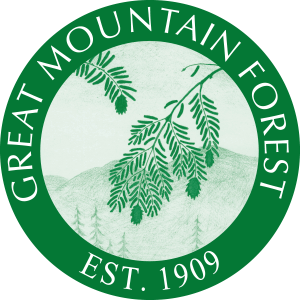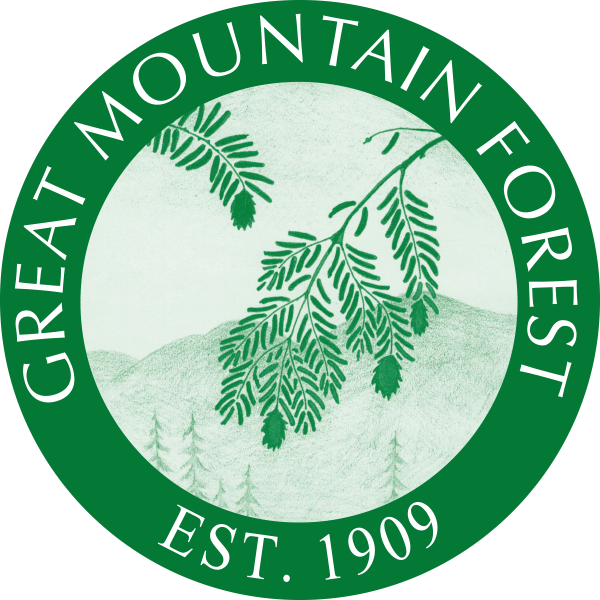Reflections from Meekertown – 24 hours alone in the forest
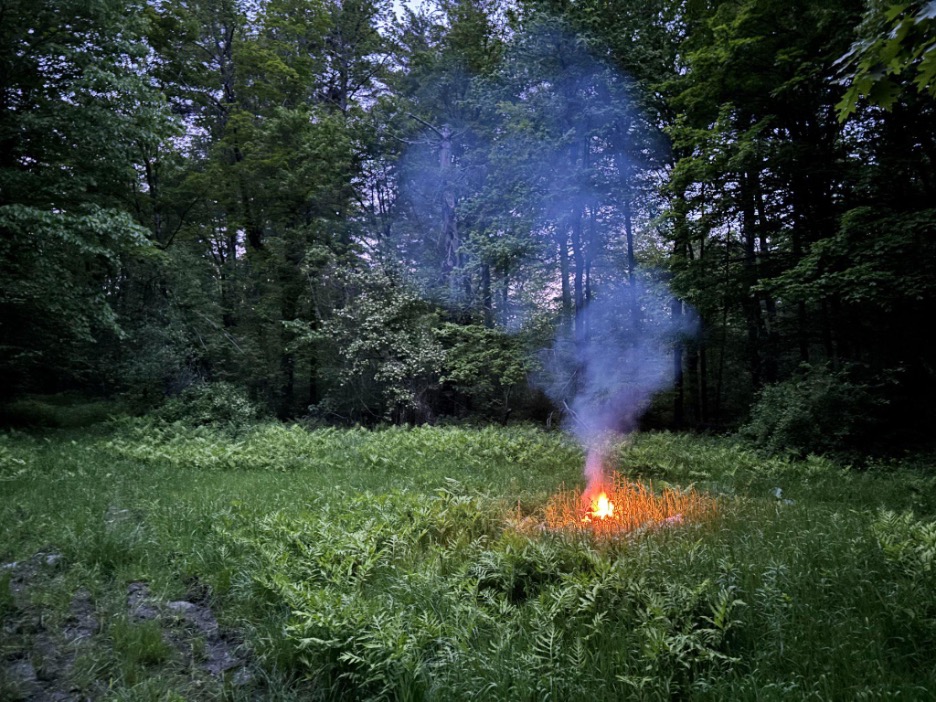
August 1, 2025
Alec Linden
Not all who wander...
In late May, in my role as GMF Newsletter Editor, I had the opportunity to spend the night at the Meekertown Cabin, a rustic but cozy outpost on the site of a onetime homestead at the southwestern extremity of this 6,300 acre forest. The objective was to produce the article you now read; whatever happened between embarking and inscribing was up to me.
In Connecticut, our forests are many, but they are crosshatched by private property, highways, and development. For all its rural charm, the fourth most densely populated state in the country offers little in the way of true wilderness. For those of us in the Northwest Corner, though, Great Mountain Forest (GMF) gives us something pretty close.
The following report is an account of a night spent alone in some of Connecticut’s deepest woodlands, with the only goal being that I allowed myself to be led by the experience instead of following a pre-planned agenda. When we’re alone in the woods, who leads us? And where do we go?
Setting out
GMF Property Manager Russell Russ picked me up on a sunny afternoon and ferried me from the East Gate entrance along the well-maintained Camp Road, onto Chattleton Road, and to the West Gate on Canaan Mountain Road.
Along the way, Russell identified the complex human interventions on the landscape that make it what it is today. Russell essentially grew up in these woods, his father Darrell being a longtime forester manager at GMF who, throughout the 20th century, essentially shaped the forest we see today alongside forester and owner Ted Childs. He pointed out a stone dam below Old Man McMullen Pond with an ancient outlet pipe, below which sits the subtle remnants of an old saw mill, once one of the major vocations of this now uninhabited stretch of highland forest. Further along, Russell explained that the stands of non-native conifers that hemmed the road had been planted as an arboretum for exotic evergreens.
As much time as Russel has spent in the forest, he was quite visibly surprised by the sight of a cow moose, grazing languidly on the Big Island of Old Man McMullen Pond, which we spotted from the window of his truck. With wide eyes, Russell said that in two and a half decades working full-time in the forest, it was the first time he’d seen a moose at this pond. While we watched, a beaver cut a clean V in the still black water just in front of the moose enjoying a leisurely lunch.

The best photo of the moose we managed, just barely within zoom range.
After exiting the forest, 15 more minutes brought us down the slopes of Canaan Mountain, out onto Route 63, and eventually onto North Goshen Road, where the chauffeured portion of my journey abruptly ended. Russell handed me a stack of paper maps, some parting bits of advice, and peeled off back to civilization.
My guides:
The ferryman
Buzzing with the anticipation of 24 hours of solitude in an unfamiliar place, I felt like Odysseus, ferried by Charon across the River Styx, even though the TV-sized display screen of his new Toyota Tacoma blared in front of my face. Russell was conveying me to an unknown frontier, depositing me at the forest’s wild southern boundary. He imparted the knowledge that would enable me to find my way through the tangle and keep me on the known path without getting lost.
But getting a little lost, of course, was part of the plan. Searching for Russell’s landmarks – the Collier’s Cliffs overlook, Pothole Falls, and several other remote curiosities of the wild Meekertown area – brought me on bushwhacking missions. I etched through thick undergrowth and scrambled up the slick bedrock exposed by the rush of Brown Brook’s cascades in a gambit to rediscover Meekertown Road, which I’d left behind some time before. Halfway up, I paused for a dip into a rust-colored pool as the light faded from the understory, and felt wonderfully a part of the darkening forest around me.
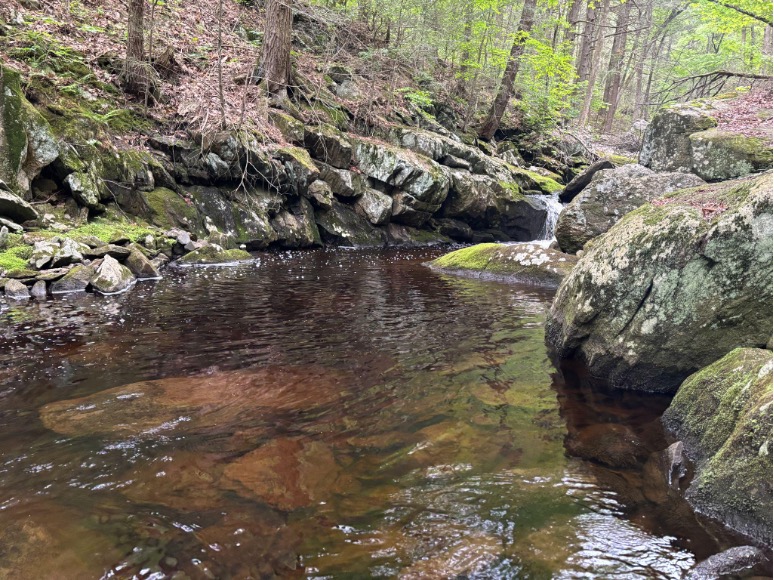
The grotto-like, rust-colored pool somewhere on Brown Brook
The bears, beavers, and beyond
I followed Russell’s directions up the verdant road until I crossed a bridge that brought me back into GMF territory and up a trail that would eventually intersect with the historic Meekertown Road near Wampee Pond. I began to spot mounds of bear droppings, a day or two old – a signpost of another type of guide in the forest.
These roads, though grown over and seldom used today, were once the conduits for thriving industry in these hills. Their legacy as thoroughfares is carried on today by the animals who have returned to habitats once wrested from them by the enterprises that built the roads.
As I arrived at Wampee Pond, taking in its boreal affect, a northern water snake cut s-shapes across the still, ink-black surface while two beavers busily reinforced a dam at an outflow of the aptly-named Brown Brook, which runs dark with the tannins of organic detritus steeping in its cold waters.
I tried to channel the animals’ movements across the landscape as guidance for my own. When multi-stemmed, heavily branched fallen trees blocked the overgrown corridor of the lower Meekertown Road, I followed the dim impression of deer tracks, to navigate the blockages obstructing my path.
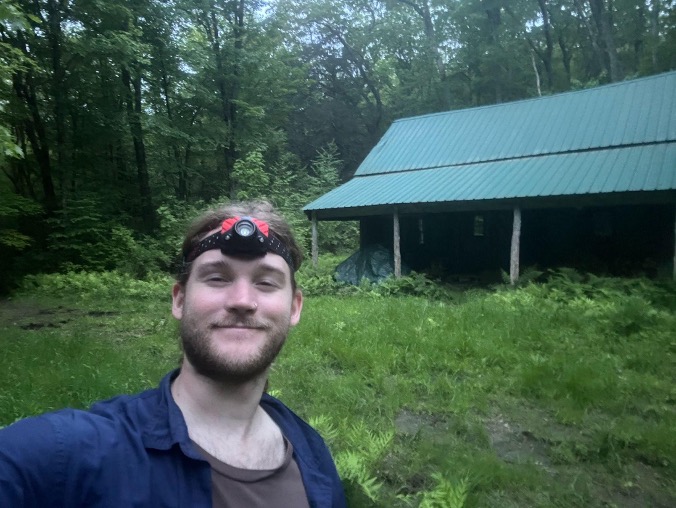
The author settling in for the evening at Meekertown Cabin
The colliers
That these animals are able to flourish – even impose their own will – upon a landscape once denuded by 19th century industrialism is remarkable. “It was a wasteland,” said former GMF director Hans Carlson on a recent phone call, emphasizing that resilience and resurgence are core aspects of GMF’s forest history. The now-verdant hills were stripped of vegetation to fuel the colliers’ fires, and the hollows subsumed by miasmas churning from charcoal hearths and pig iron blast furnaces.
When the colliers tended their fires here, there would have been no bears sharing the roads, no beavers laboring in Wampee Pond (which didn’t exist – it was dammed in the early 20th century as waterfowl habitat and forest fire protection). Traces of their hearths are found throughout the forest, and the Meekertown area would have been sporadically populated by these solitary, hardened men who were likely haunted by their desolated landscape.
There are lurid stories of murder and mischief whispered about the past inhabitants of Meekertown. In 1820, a clergyman described the settlement as a “hamlet of heathens, living in intellectual, moral, and spiritual darkness,” which GMF recently immortalized in a series of t-shirts and is also referenced in the name of a beer brewed by nearby Norbrook Brewery called “Hamlet of Heathens,” brewed with wild Meekertown-foraged hops.
While this reputation may have had some credence, the truth is that they were opportunistic, and maybe a little introverted, individuals who made their way in a difficult world. In any case, their stories, and the remnants of their hearths and shanties left behind, animate the landscape with a colder, more imperfectly human history entangled with the vibrancy of the forest that flourishes today.
Meekertown Road is split in two, where Brown Brook burbles over the long-collapsed remnants of a bridge before it cascades to the valley floor below. While I sat in that spot, listening to the tea-stained water rush over the rocks, the occasional roar of a semitruck from Route 63 broke through my reverie. GMF, as wild as it feels today, is still susceptible to industrial intrusions from time to time.
While the colliers may have not been focused on the trees and birds like many of our modern forest goers, they were certainly attuned to their fires. I meant to avoid cosplaying collier during my overnight stay at the cabin, but as evening fell I found myself tending to a smoldering blaze in the clearing just outside the building.
It’s difficult to imagine the life of a collier, staring intently at a pile of timber and earth for weeks on end, measuring its interior heat by the color of the smoke that rose from the mound. There would have been none of the hooting barred owls or rustle of the breeze in the treetops then. I have a note in my journal that I must have scribbled out there: “It’s amazing how long you can watch fire. It’s almost difficult to do anything else.”
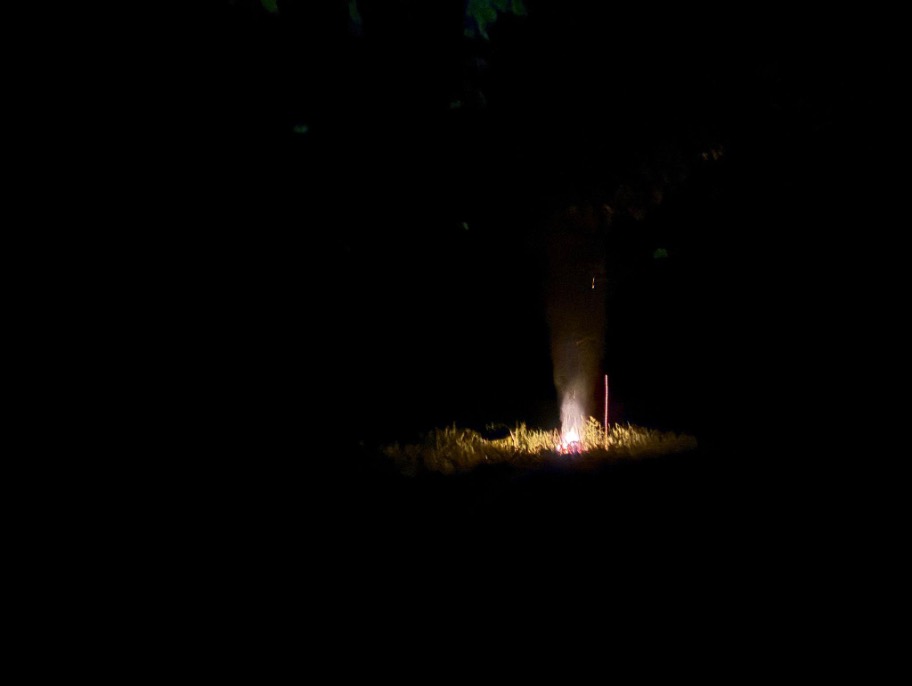
The storyteller
I woke the next morning on the wooden floor of the cabin, the beaming sunshine illuminating the many inscriptions etched into the walls from the scout troops, artists, and hunters who had previously taken refuge within its walls. The two rocking chairs which face the formidable hearth at the front of the room sat eerily still as dust motes fluttered in the sunbeams.
“Don’t sit in Mrs. Dean’s rocking chair!” GMF trustee and forester Star Childs had told me the day before with a mischievous grin. “If it starts rocking, get outta there.” Luckily, nothing moved during my short stay – that I saw, at least.

Which one is Mrs. Dean’s?
Having my route back to the East Gate more or less mapped out, I contemplated backtracking east on Meekertown Road a little bit to search for the gravesite of several onetime residents. The late environmentalist and poet David Leff wrote rhapsodically about GMF’s landscape, its tenacity and will to survive, and he described its former inhabitants with the same reverence.
“Meekertown’s ghosts are never frightened,” he wrote in a yet-unpublished paean to the forest. “Their tales linger.” On his own visit to the graves, Leff reflected somberly on their memory: “We show our respect by quietly keeping the stories alive, as best we can.”
Leff’s writing guided me to try and see the forest as he did – as a patchwork of animations and presences, each contingent upon the other. Leff showed that GMF is constituted by the stories that dwell in the minds of the foresters who have spent their lives within it, and the memory of those who made homes and lost them here, just as much as it is by its trees, hills, and hollows.
Having fulfilled my bushwhacking quota the previous evening tromping around Meekertown, I decided to let the graves lie. And anyways, as presumably solitary individuals in life, maybe they appreciate their alone time in death too.
A guide for the reader
With that decision made, I turned left onto GMF’s north-south arterial, the refreshingly obvious and debris-free Number 4 Trail, and began my journey home. What follows here is my attempt to pay it forward: as I was guided through my time in the forest, perhaps this suggested route – which I can confirm is well worth it – will inspire the intrepid rambler to undertake their own journey from GMF’s wild southern reaches to the East Gate Campus..
As a disclaimer, any distances given are estimations, and anyone wishing to walk these trails should consult a map, available on the GMF website.
Find your way to the intersection of Meekertown Road with the Number 4 Trail. Getting to this point means either hiking in on route of your choosing, or devising another creative access plan. For a detour to the Meekertown Cabin, follow Meekertown Road west about a half mile to a clearing where the cabin is easily seen, then turn around and head back to the junction. For those who want to skip the cabin, start heading north on the Number 4 Trail with Wampee Pond to the right. Make sure to spend a minute searching the surface for disturbances from snakes or busy beavers.
Continue up the Number 4 Trail for another 2/3 of a mile or so before coming to a small clearing on the left after a bit of an incline. At the back of this clearing, an obvious but small trail leads to the best view I’ve seen so far in the forest: Wapato Lookout.
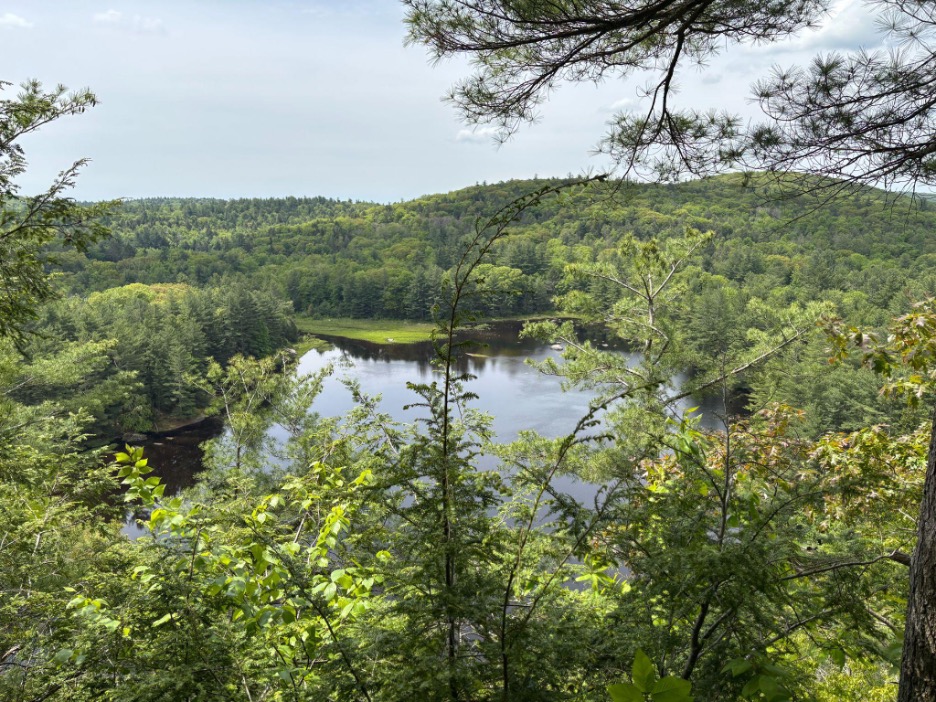
The view. It’s even better in person.
From a dramatic precipice, the view extends through a white pine-framed window over the black waters of Wapato Pond and rolling peaks beyond, exemplary of the adage that GMF often feels more like New Hampshire’s deep woods than southern New England. I spent a good 45 minutes here, swatting mosquitos and enjoying a respite on the bouncy, needle-strewn soil. It’s the type of spot one could spend quite a bit more time at with the right schedule.
Heading back to the Number 4 Trail, continue north for a little over a mile through varied woodlands until the Sam Yankee Trail peels off to the left. Follow it for a few hundred yards, until a well-marked sign points left to the Matterhorn. Enjoy the short but stimulating climb to the rocky precipice in the heart of GMF, with nothing but rolling woodlands around you. Enjoy your lunch here, and be careful with the lichens.
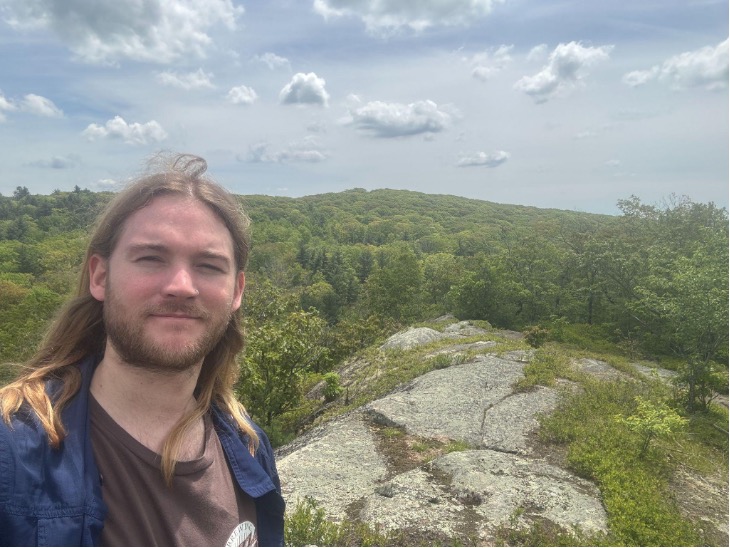
The author, post-lunch and perched on the Matterhorn
Backtrack to the trusty Number 4 Trail, and continue heading north. After another mile or so, turn right, rounding a gate onto the Crissey Trail, where a mystical forest of hemlock and slim maples towers above a formidable network of low stone walls.
After a while, turn left onto the shady and boulder-strewn Crossover Trail. If inclined, take a detour to the Crissey Pond overlook for another fabulous view. Head back to the Crissey Trail and continue on to GMF’s famed glacial erratics, large boulders dropped during the retreat of the Laurentide Ice Sheet. As a rock climber, I found myself atop one of them, hanging out with a ruby-throated hummingbird on a bed of ferns and moss.
The Crossover Trail spills out to the Camp Road, where one can head back to the East Gate through a corridor of hemlocks and yellow birches for another taste of the north country, making sure to stop at the model charcoal pile exhibit demonstrates the complexity of charcoal fires.
My iPhone clocked the total mileage, with all the detours, to be between seven and eight miles. For those who want more, a spur loop to visit the prehistoric Tobey Bog can be achieved via the Overlook Trail, Charcoal Pit Trail, and Tobey Bog Trail.
Happy hiking!
About the Author
Alec Linden is a news reporter, environmental storyteller, and researcher based out of Norfolk. After completing a master’s degree in environmental governance and policy at the University of Oxford in 2023, Alec moved back to the Northeastern US to begin a career caring and advocating for the hills, ravines, and rivers that he cherished growing up in downstate New York. Alec relocated to the Northwest Corner in the summer of 2024 to become a reporter with the Lakeville Journal, and now helms newsletter and copy editing duties for GMF. During his down time, Alec spends as much time as possible on skis, and in the warmer months pokes around the woods of the Berkshires and Taconics to search for new rock climbing routes.
